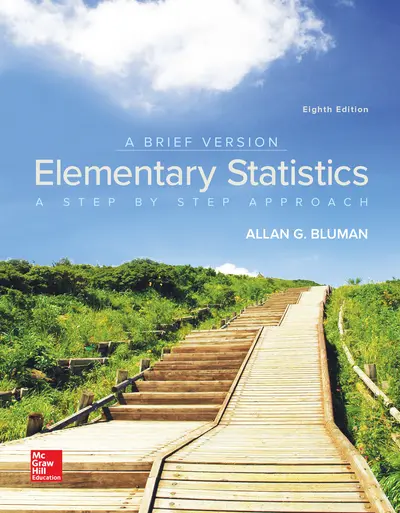My Account Details

ISBN10: 1259969436 | ISBN13: 9781259969430

* The estimated amount of time this product will be on the market is based on a number of factors, including faculty input to instructional design and the prior revision cycle and updates to academic research-which typically results in a revision cycle ranging from every two to four years for this product. Pricing subject to change at any time.
Instructor Information
Quick Actions (Only for Validated Instructor Accounts):
Elementary Statistics: A Brief Version was written as an aid in the beginning Statistics course for students whose mathematical background is limited to basic algebra. The book follows a nontheoretical approach without formal proofs, explaining concepts intuitively and supporting them with abundant examples. The applications span a broad range of topics including problems in business, sports, health architecture, education, entertainment, political science, psychology, history, criminal justice, and many more. While a number of important changes have been made in this next edition, the learning system remains untouched and provides students with a useful framework in which to learn and apply concepts.
Elementary Statistics: A Brief Version, 8e
Chapter 1: The Nature of Probability and Statistics
1.1, Descriptive and Inferential Statistics
1.2, Variables and Types of Data
1.3, Data Collection and Sampling Techniques
1.4, Experimental Design
1.5, Computers and Calculators
Chapter 2: Frequency Distributions and Graphs
2.1, Organizing Data
2.2, Histograms, Frequency Polygons, and Ogives
2.3, Other Types of Graphs
2.4, Paired Data and Scatter Plots
Chapter 3: Data Description
3.1, Measures of Central Tendency
3.2, Measures of Variation
3.3, Measures of Position
3.4, Exploratory Data Analysis
Chapter 4: Probability and Counting Rules
4.1, Sample Spaces and Probability
4.2, The Addition Rules for Probability
4.3, The Multiplication Rules and Conditional Probability
4.4, Counting Rules
4.5, Probability and Counting Rules
Chapter 5: Discrete Probability Distributions
5.1, Probability Distributions
5.2, Mean, Variance, Standard Deviation, and Expectation
5.3, The Binomial Distribution
Chapter 6: The Normal Distribution
6.1, Normal Distributions
6.2, Applications of the Normal Distributions
6.3, The Central Limit Theorem
6.4, The Normal Approximation to the Binomial Distribution
Chapter 7: Confidence Intervals and Sample Size
7.1, Confidence Intervals
7.2, Confidence Intervals for the Mean When σ Is Known
7.3, Confidence Intervals for the Mean When σ Is Unknown
7.4, Confidence Intervals and Sample Size for Proportions
7.5, Confidence Intervals for Variances and Standard Deviations
Chapter 8: Hypothesis Testing
8.1, Steps in Hypothesis Testing – Traditional Method
8.2, z Test for a Mean
8.3, t Test for a Mean
8.4, z Test for a Proportion
8.5, Chi-Square Test for a Variance or Standard Deviation
8.6, Additional Topics Regarding Hypothesis Testing
Chapter 9: Testing the Difference Between Two Means, Two Proportions, and Two Variances
9.1, Testing the Difference Between Two Parameters
9.2, Testing the Difference Between Two Means: Using the z Test
9.3, Testing the Difference Between Two Means of Independent Samples: Using the t Test
9.4, Testing the Difference Between Two Means: Dependent Samples
9.5, Testing the Difference Between Two Proportions
9.6, Testing the Difference Between Two Variances
Chapter 10: Correlation and Regression
10.1, Correlation
10.2, Regression
10.3, Coefficient of Determination and Standard Error of the Estimate
Chapter 11: Chi-Square and Analysis of Variance (ANOVA)
11.1, Test for Goodness of Fit
11.2, Test Using Contingency Tables
11.3, Analysis of Variance (ANOVA)
Appendix A: Tables
Appendix B: Data Bank
Appendix C: Glossary
Appendix D: Selected Answers
Additional Topics Online
Algebra Review
Writing the Research Report
Bayes' Theorem
Alternate Approach to the Standard Normal Distribution
Accessibility
Creating accessible products is a priority for McGraw Hill. We make accessibility and adhering to WCAG AA guidelines a part of our day-to-day development efforts and product roadmaps.
For more information, visit our accessibility page, or contact us at accessibility@mheducation.com
Need support? We're here to help - Get real-world support and resources every step of the way.